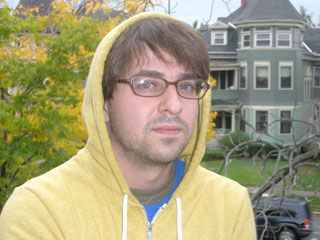A Thousand Nights in a Night
by Aaron Lowinger

Those who have been fortunate to see any of Scott Puccio’s films in recent years were not surprised to learn that his MFA thesis project, The Film of the Thousand Nights and a Night, vol. 2, was accepted into last month’s New York Film Festival. His intensely handmade and heartfelt films carve a particular place on the screen that, however filtered from real experience, build their own emotional reality. For Puccio, the unexpected is always a delight—a cool approach to experimental film. They remind us that something special is happening right now. Watching his silent films—the rapidly winding projector serving as soundtrack—is an intimate experience not to be missed.
1001 Nights, the film, is Puccio’s attempt to build an epic out of small pieces and fragments, much in the way the work’s namesake is a whole, made up of many distinct and smaller constituents. Inspired by the 20th century’s treatment of the epic from Joyce’s Ulysses, Williams’ Paterson and particularly Olson’s Maximus Poems, Puccio’s film resists narrative altogether in favor of a visual syntax in which images and text are orchestrated into a flowering poetic world. The speed at which the images flicker on the screen cannot be understated. “My films are so short they play with the idea of epic lengths,” Puccio admits. “I am interested in the possibility of films lasting under one second.” The end result is a 30-minute film composed of 501 films ranging from less than a second to 10 seconds and longer.
One thing that good experimental film can do is open a new way of using one’s eyes. Film is uniformly divided into 24 frames per second. Therefore, looking at one second’s worth of filmstrip of a typical commercial film would reveal 24 nearly identical pictures. Scott Puccio’s approach to film begins with the film itself, that part of the medium which one can put their hands on. Most of 1001 Nights is made without a camera at all. The films are composed of static images from various print media (largely magazines) that are cut out by hand and placed on a strip of film. They are short, rapidly disappearing images that call for a radically different kind of viewing.
The project openly attempts to find a home across media. Puccio envisions the film as taking three forms: a film, a book (with photographs of filmstrips and titles of all films) and a Web site. In fact, Puccio sees 1001 Nights as filmic text, true to the namesake epic. To this end, the film is infused with dozens of titles, which unwrap, reveal, conceal and aim in multiple, somehow linked directions. Titles like “Street Samurai,” “Yellow Trees,” “Bus Stop Blow Job” and “Old Man Smith After a Hard Day of Being Old Just Wants to Listen to His Old Radio and Drink Manhattans,” create a contextual textual weight from which the films spin off. This style is highly reminiscent of the work of Albany poet Matthew Klane, whom Puccio has invited to perform alongside his films. The insistent poetic attentions in 1001 Nights further demands one to read the film, to watch the book.
This filmmaker made Buffalo look first-rate fine last month at the New York Film Festival, despite being forced to project the film with a dim replacement bulb. Having studied with David Gatten at Ithaca College and Phil Hoffman at York University in Toronto, Puccio has done his share to expand the audience for experimental film in Buffalo from hands on up. His bulb is shining bright.
Scott Puccio will be screening his films, including The Film of a Thousand Nights and Night, vol. 2, on Sunday, November 11, at 7pm at Betty’s Restaurant, 370 Virginia Street. Poet Matthew Klane will also read.
|
Issue Navigation> Issue Index > v6n45: Who Really Killed JFK? (11/8/07) > A Thousand Nights in a Night This Week's Issue • Artvoice Daily • Artvoice TV • Events Calendar • Classifieds |









 Current Issue
Current Issue